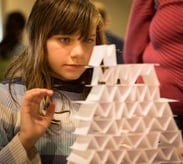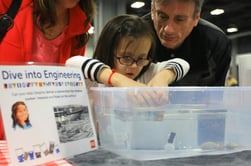As educators, we want to teach our lessons in the most effective way to ensure our learners retain and understand what they’re learning. But we also want to make sure students are engaged and interested in their work, because we know everyone has their own specific needs when it comes to their personal learning style.
 Hands-on learning, also called experiential learning and learning by doing, is uniquely positioned to support or elevate any type of learner — students that prefer auditory lessons can hear the instructor as they follow along, while those that do well with visuals can watch and learn throughout the process.
Hands-on learning, also called experiential learning and learning by doing, is uniquely positioned to support or elevate any type of learner — students that prefer auditory lessons can hear the instructor as they follow along, while those that do well with visuals can watch and learn throughout the process.
One Perdue study compared the test scores of 8th grade science students to try and determine the efficacy of different teaching styles. One group of students learned about water quality through a familiar lecture format, while the other group of students were asked to build a water purification device as their learning experience. The students who went through active learning, building the water purification device with their own hands, saw much higher test scores and improvement rates in related academics than the lecture-format group.
This same study also found evidence that hands-on learning better supports non-native English speakers by removing parts of the language barriers involved in traditional learning. Researchers noted that ESL students in the group were able to use drawings, words or simple phrases to explain themselves and their thoughts, putting them more at ease to express what they had learned.
Another study, through Proceedings of the National Academy of Sciences of the United States of America (PNAS), found that students who didn’t engage in hands-on learning in science, engineering, and mathematics lessons were almost 2x more likely to fail a course than students who did.
 Research has shown that hands-on learning better engages both sides of the brain than visual or auditory learning alone. Listening and analyzing occur in the left hemisphere of the brain, while visual and spatial processes are handled in the right hemisphere. By combining multiple styles of learning, the brain forms stronger overall connections and is able to store more relevant information. Brain scans also show increased activity in sensory and motor-related areas of the brain when thinking about science concepts that participants had hands-on experiences with.
Research has shown that hands-on learning better engages both sides of the brain than visual or auditory learning alone. Listening and analyzing occur in the left hemisphere of the brain, while visual and spatial processes are handled in the right hemisphere. By combining multiple styles of learning, the brain forms stronger overall connections and is able to store more relevant information. Brain scans also show increased activity in sensory and motor-related areas of the brain when thinking about science concepts that participants had hands-on experiences with.
Thats why, when we build resources — from games and quizzes to standards-aligned units from Pre-K through 8th grade — we focus on active, or hands-on learning. Because we know when you’re hands-on, you’re minds-on.








